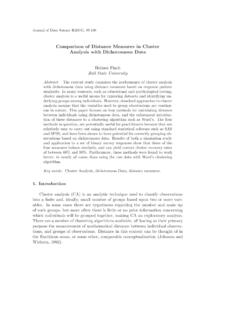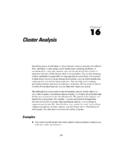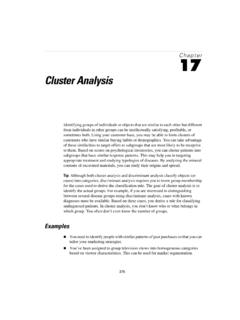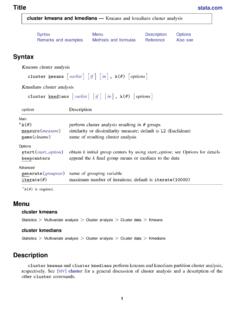Transcription of Phylogenetic Tree Computation Tutorial
1 15/6/02 Frank Olken - PGA PhylogenyTutorial1 Phylogenetic TreeComputation TutorialFrank OlkenLawrence Berkeley National LabPresentation to PGA CourseMay 3, 2002 Berkeley, California5/6/02 Frank Olken - PGA PhylogenyTutorial2 Overview Introduction: What? Why? .. Multiple Sequence Alignment Computing Phylogenetic Trees Merging Trees Resources Funding Sources25/6/02 Frank Olken - PGA PhylogenyTutorial3 Introduction5/6/02 Frank Olken - PGA PhylogenyTutorial4 Example Seq. A = A A C C G G T T Seq. B = A A C C G G T G Seq. C = A C C C G G T C Seq. D = A C C C G G T AABCDABCDU nrootedTreeRootedTree35/6/02 Frank Olken - PGA PhylogenyTutorial5 similarity vs. Homology Similar sequences resemble one another Homolog sequences derived from common ancestor Ortholog homologous sequences within a species Paralog homologous sequences between species5/6/02 Frank Olken - PGA PhylogenyTutorial6 Ortholog vs.
2 Paralog Ortholog genomic variation occurs afterspeciation hence can be used forphylogeny of organism Paralog genetic duplication occurs beforespeciation hence not suitable forphylogeny of organism45/6/02 Frank Olken - PGA PhylogenyTutorial7 Homoplasy Sequence similarity NOT due to commonancestry May arise due to parallelism or convergentevolution Parallelism Convergent evolution5/6/02 Frank Olken - PGA PhylogenyTutorial8 Phylogenetic tree Binary tree ( , fan-out from nodes = 2) Variously rooted or unrooted tree topology Branch lengths (evolutionary time)55/6/02 Frank Olken - PGA PhylogenyTutorial9 Phylogeny of what? Organisms Whole genome phylogeny Ribosomal RNA (surrogate for whole genome) Strains (closely related microbes) Individual genes (or gene families) Repetitive DNA sequences Metabolic pathways Secondary Structures Any discrete character(s) Human languages Microbial communities5/6/02 Frank Olken - PGA PhylogenyTutorial10 Why compute phylogenetictrees?
3 Understand evolutionary history Map pathogen strain diversity for vaccines Assist in epidemiology Of infectious diseases Of genetic defects Aid in prediction of function of novel genes Biodiversity studies Understanding microbial ecologies65/6/02 Frank Olken - PGA PhylogenyTutorial11 Rooted vs. Unrooted tree Root - ancestor of all taxa considered Unrooted tree - typical result, unknown commonancestor Rooted tree - known common ancestor Specify root by means of outgroup Outgroup is distant from all other taxa example: mammals and a salamander ancestor of outgroup is presumed root5/6/02 Frank Olken - PGA PhylogenyTutorial12 Which Sequences ? DNA Very sensitive, non-uniform mutation rates cDNA/RNA Useful for more remote homologies Protein Sequences Useful for most remote homologies, deepphylogenies, more uniform mutation rates,more character states75/6/02 Frank Olken - PGA PhylogenyTutorial13 Ribosomal RNA 16S Sequences These sequences exist in all organisms They are highly conserved Hence suitably for broad, very deepphylogeny studies Compiled for tens of thousands oforganisms, mostly microbial Unsuited to fine grained phylogeny5/6/02 Frank Olken - PGA PhylogenyTutorial14 What is to be computed?
4 tree topology branching order root Branch lengths (evolutionary time) Ancestral sequences tree figure of merit ( , likelihood) tree reliability85/6/02 Frank Olken - PGA PhylogenyTutorial15 Computational Process Get DNA/RNA/Protein Sequences Construct multiple sequence alignment Compute pairwise distances (for distance methods) Build tree : topology + branch lengths Estimate reliability Visualize5/6/02 Frank Olken - PGA PhylogenyTutorial16 Multiple Sequence Alignment95/6/02 Frank Olken - PGA PhylogenyTutorial17 Multiple Sequence Alignment Align sequences so that correspondingpositions are in same columns Pad missing nucleotides as nulls whereneeded Each column then becomes a singlecharacter in the phylogeny computation5/6/02 Frank Olken - PGA PhylogenyTutorial18 Multiple Sequence Alignment NP-hard Worst case computational complexity isexponential in number of problem size In practice, often use greedy algorithms choose best incremental change in solution no backtracking Figure of merit.
5 Sum of pair-wise edit distances105/6/02 Frank Olken - PGA PhylogenyTutorial19 Multiple Sequence AlignmentAlgorithms Dynamic Programming Hidden Markov Models Stochastic Context Free Grammars5/6/02 Frank Olken - PGA PhylogenyTutorial20 Dynamic Programming MSA -Sequential Addition Compute pairwise edit distances betweensequences via dynamic programming Merge closest pair Generate consensus sequence Merge sequence closest to consensussequence alignment115/6/02 Frank Olken - PGA PhylogenyTutorial21 Dynamic Programming MSA -Bottom Up Merging Compute pairwise edit distances betweensequences via dynamic programming Merge closest pair Replace merged pair with consensussequence Recompute pairwise edit distances, andmerge closest pair ..5/6/02 Frank Olken - PGA PhylogenyTutorial22 Hidden Markov Model MSA Estimate HMM for set of sequences Compute most probable alignment of eachsequence to HMM Use this as basis for MSA HMM allows probabilistic representation of consensus sequence 125/6/02 Frank Olken - PGA PhylogenyTutorial23 SCFG MSA Algorithm Estimate Stochastic Context Free Grammarfor set of ribosomal RNA sequences ( ,16S sequences)
6 Compute most probable sequence alignmentto SCFG for each sequence Use this as basis of multiple sequencealignment Preserves RNA secondary structure in MSA5/6/02 Frank Olken - PGA PhylogenyTutorial24 Algorithms for computingphylogenetic trees135/6/02 Frank Olken - PGA PhylogenyTutorial25 Evaluation Criteria for TreeComputational Methods Accuracy Explicit statistical model of evolution ? Efficient use of data Computation Time Branch lengths ? Quality measure ? Reliability measure ?5/6/02 Frank Olken - PGA PhylogenyTutorial26 Computational Approaches toPhylogenetic tree Computation Distance-based methods UPGMA, Neighbor joining Maximum Parsimony Method Maximum Likelihood Methods tree merginng Consensus trees, supertrees145/6/02 Frank Olken - PGA PhylogenyTutorial27 Distance vs.
7 Character StateMethods Distance Methods UPGMA, Neighbor Joining, Min. Evol., .. Requires distance measures between sequences Suitable for continuous characters Character State Methods Max. parsimony, Max. Likelihood, .. Requires discrete characters5/6/02 Frank Olken - PGA PhylogenyTutorial28 similarity Measures similarity Measure bigger value = more similar Distances bigger value = less similar triangle inequality |x,y| + |y,z| < or = |x,z| often assumed additive for distance-basedphylogenetic tree construction155/6/02 Frank Olken - PGA PhylogenyTutorial29 Can distance-based methods usesimilarity measures? Maybe .. Depends on whether distance methods uses: triangle inequality additive distance measure5/6/02 Frank Olken - PGA PhylogenyTutorial30 Simple distances betweensequences Number of differing positions Weighted differences Edit distances (weighted sum of inserts,deletes, substitutions) Weighted Substitution Cost Matrices PAM, BLOSUM Poisson Corrections (next slide)165/6/02 Frank Olken - PGA PhylogenyTutorial31 Distance Metric BetweenSequences p = n_d / n = number of characters which differ / totalnumber of characters p is not proportional to evolutionary time Reason: sites can mutate more than once Poisson correction.
8 D = - ln (1-p)5/6/02 Frank Olken - PGA PhylogenyTutorial32 similarity Measure for ProteinStructures Construct contact map (graph) for each proteinstructure vertex = residue (amino acid) edge = distance between AA s is less than 5 Angstroms Compute pairwise alignment between structures nonoverlapping matching of residues similarity Measure = number of shared edges from contact graphs175/6/02 Frank Olken - PGA PhylogenyTutorial33 UPGMA Distance Method Unweighted Pair Group Method UsingArithmetic Mean by Sokal and Michener, 1958 Merge closest pair of taxa (by distance) Recompute distances to merged node viamean of pairwise distances to leaves Repeat5/6/02 Frank Olken - PGA PhylogenyTutorial34 UPGMA Method Fast to compute Implicitly assume molecular clock , uniform mutation rates across sites andbranches185/6/02 Frank Olken - PGA PhylogenyTutorial35 Neighbor Joining DistanceMethod Compute pairwise distances, d(i,j), set L = all leaves T Compute D(i,j) = d(i,j) - (r(i)+r(j)) r(i) = average distance to other leaves Merge closest pair of sequences i and j for new k, set d(k,m) = 1/2 (d(i,m)+d(j,m)-d(i,j)) for m in L Add k to T with set d(i,k) = 1/2 (d(i,j)+r(i)-r(j)) set d(j,k) = d(i,j)-d(i,k)
9 Replace i and j with k in L Repeat5/6/02 Frank Olken - PGA PhylogenyTutorial36 Neighbor Joining Generates unrooted trees Assumes additive distances in tree195/6/02 Frank Olken - PGA PhylogenyTutorial37 Merits of Distance Methods Fastest method Not very accurate or efficient use of data Can use continuous data (not just sequences) No statistical model of evolution No figure of merit No branch lengths5/6/02 Frank Olken - PGA PhylogenyTutorial38 Maximum Parsimony Minimize total number of state changesalong all paths in tree Intermediate computational cost Figure of merit = number of state changes No statistical model No branch lengths205/6/02 Frank Olken - PGA PhylogenyTutorial39 Maximum Likelihood L = p (data | tree , branch lengths, model) Search trees, branch lengths to find max L This is MLE tree Algorithms: generate tree topology optimize branch lengths retain if best seen loop5/6/02 Frank Olken - PGA PhylogenyTutorial40 Maximum Likelihood Methods Explicit statistical model Figure of merit = log likelihood Computes branch lengths Very expensive to compute, use heuristics Reliability estimation by resampling Efficient use of sequence data Examples: Phylip/dnaML, fastdnaML215/6/02 Frank Olken - PGA PhylogenyTutorial41 Maximum Likelihood Estimaton- Assumptions Characters (nucleotide positions) evolveindependently Mutation Rate variation.
10 Molecular clock ==> uniform rates acrosspositions and branches We can allow rate to vary by position (usuallyassume Gamma distribution) Requires that estimate more parameters5/6/02 Frank Olken - PGA PhylogenyTutorial42 MLE Phylogenetic TreeConstruction Algorithms Must compute both tree topology, branch lengths, rates ofevolution (for each position) Too many tree topologies to search exhaustively Hence heuristic tree search Order taxa (randomly?) Build tree incrementally For each taxa, consider all possible locations in existing tree toinsert Compute likelihood for each possible insertion point. Choose best insertion point Get next taxa225/6/02 Frank Olken - PGA PhylogenyTutorial43 MLE Phylogenetic TreeAlgorithms Branch swapping Given tree Consider all possible pairwise branch swaps,where branches within distance k in tree For each possible swap reoptimize branch lengths compute likelihood of resulting tree5/6/02 Frank Olken - PGA PhylogenyTutorial44 MLE Phylogenetic TreeAlgorithms Overview of algorithm Pick next taxa Generate possible topologies Perform branch optimization for each topology Compute likelihood of resulting tree Retain best k trees Get next taxa235/6/02 Frank Olken - PGA PhylogenyTutorial45 Popular MLE Codes dnaML - Joe Felsenstein (U.)





